Tsumago
Today we left Kyoto for Tsumago. This is again a more distant village that requires different modes of transportation to reach. We chose to take the Shinkansen ![]() Hikari to Nagano, because it’s a really fast way of traveling. After that we took the express train to Nakatsugawa and another train to Nagiso. Finally, after taking a bus, we arrived in Tsumago.
Hikari to Nagano, because it’s a really fast way of traveling. After that we took the express train to Nakatsugawa and another train to Nagiso. Finally, after taking a bus, we arrived in Tsumago.
Tsumago is an old post town ![]() from the Edo period. Inhabitants continually take care to keep the historic feeling and it’s something that you notice everywhere. Tsumago was the 42nd town of 69 on the Nakasen-do route.
from the Edo period. Inhabitants continually take care to keep the historic feeling and it’s something that you notice everywhere. Tsumago was the 42nd town of 69 on the Nakasen-do route.
Upon arrival at our ryokan Fujioto we are taken to the room almost immediately. A short introduction later, we can enjoy a nice cup of green tea ![]() and rest a little bit from our long journey.
and rest a little bit from our long journey.
When we want to go out for lunch, the master of our ryokan tells us not to eat too much because dinner will be a lot of food. He accompanies us to a nearby restaurant and gives a bit of explanation on the different foods they have here. We order some small filled buns, called Oyaki.
After lunch it was about time to take a look in and around Tsumago. We notice a lot of little cozy shops carrying a multitude of different things. It jumps out that a lot here is made out of wood (cypress) and we even see some store owners creating new things out of wood, new hats, cups, etc. They also sell a lot of tasty local specialties, such as gohei-mochi and candy ![]() .
.
We also visit the local temple, Kotaku-ji, which has a wooden floor with the well known “nightingale floors”. Just outside of the temple, there’s also a very nice view on the surrounding area. Behind the temple is the old school building, but it’s not been used for a long time and shows some decay.
Afterwards, we visit the Honjin and Waki-Honjin museum. Every post town needed these buildings in the old days in case they had official visitors staying for the night. The Honjin was meant for the emperor ![]() and the Waki-Honjin for his company. Unfortunately, the emperor only ever stayed here for 30 minutes, but it makes for a nice museum. We are told here that the trees in the surrounding forests are protected via all kinds of laws and that it has been like that since the Edo period. Back then, chopping down a tree was punished by cutting of your head and for the branch of a tree, an arm was the counterpart that was taken.
and the Waki-Honjin for his company. Unfortunately, the emperor only ever stayed here for 30 minutes, but it makes for a nice museum. We are told here that the trees in the surrounding forests are protected via all kinds of laws and that it has been like that since the Edo period. Back then, chopping down a tree was punished by cutting of your head and for the branch of a tree, an arm was the counterpart that was taken.
We went back to the ryokan in time to enjoy a nice warm bath before dinner. At 6 o’clock, dinner was served, and it was worth it. Very nice delicacies, tempura ![]() , grilled trout
, grilled trout ![]() , sashimi
, sashimi ![]() , steak in miso sauce (no kobe beef, but the local massaged cow type), gohei-mochi and a dessert. All of this was accompanied by a local sake
, steak in miso sauce (no kobe beef, but the local massaged cow type), gohei-mochi and a dessert. All of this was accompanied by a local sake ![]() which we were able to choose upon check-in.
which we were able to choose upon check-in.
Quite stuffed, we went outside for a little look around town in the dark. We got some nice pictures out of it, but what we remember the most is the beautiful view on the starry skies ![]() . So many stars are visible here, it seems they never heard of light pollution here in the mountains.
. So many stars are visible here, it seems they never heard of light pollution here in the mountains.
The next morning, we get an extensive breakfast to get some good energy which we’ll need for the walk to Magome.
It’s and 8 km hike to Magome and the biggest part is uphill. En route, you come by different nice views. Waterfalls, beautiful scenery, and bells ![]() , to use when you meet a bear
, to use when you meet a bear ![]() which isn’t unusual here.
which isn’t unusual here.
Once in a while we meet hikers going in the other direction, but with the time being still early in the day, it doesn’t occur too often. A while after we passed the halfway mark, we are called in to a house where they offer us a cup of tea and some sweets to enjoy them together with the other hikers that pass here. The host takes care of the entertainment with a couple of songs.
We continue on our way to Magome togo, the highest point of the trail. When we finally get here, we know the worst part is over and we can take it a bit easier walking downwards. As we get closer to Magome town, we meet other hikers more often, even whole groups with guide are crossing our path.
Arriving at Magome, there is a wonderful lookout point where you can enjoy the magnificent landscape.
Magome looks a lot like Tsumago, old houses, museum, temple, shops. First and foremost, we collect our certificate, which you can get after hiking the trail. It’s a nice souvenir printed on a wooded paper of a cypress tree. We had our lunch at Magome, walked around the town and temple a bit and enjoyed the view.
Around 3 o’clock we take the bus ![]() back to Tsumago.
back to Tsumago.
Here we can enjoy a nice warm bath again, followed by a stunning dinner. Grilled chicken, shabu-shabu (yumyum!!), slowcooked trout, beef sashimi, tempura, steamed chicked, mushrooms ![]() and a nice dessert.
and a nice dessert.
Tomorrow morning it’s time to leave again, this time we continue our journey to Tokyo.



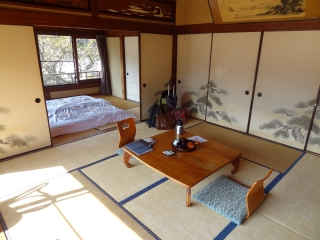
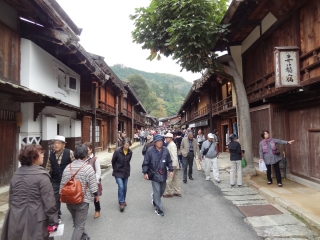
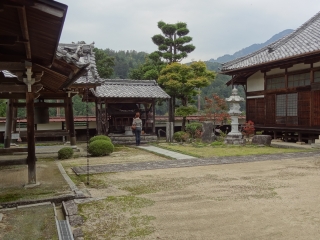
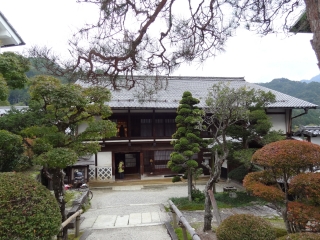
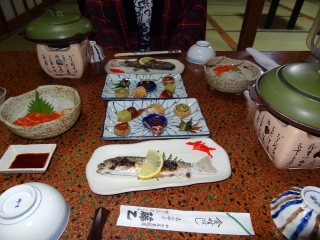
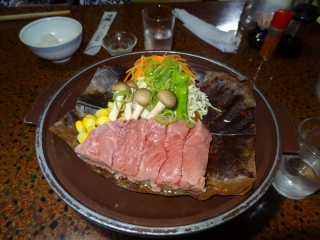
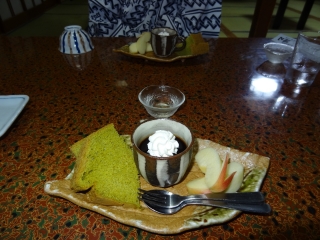
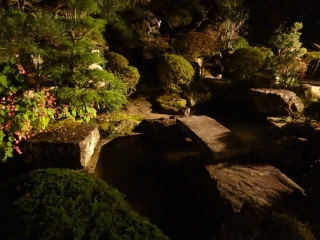
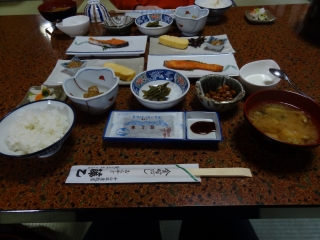
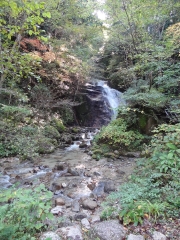
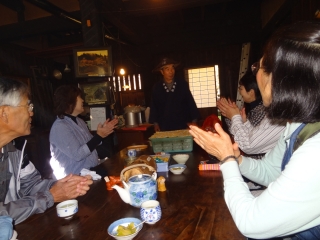
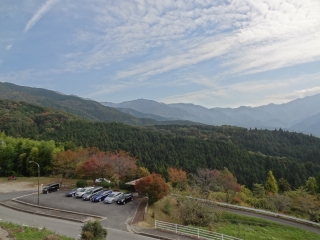
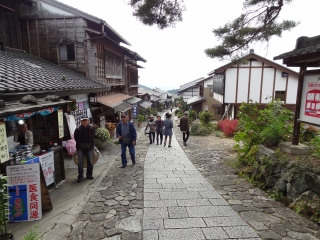
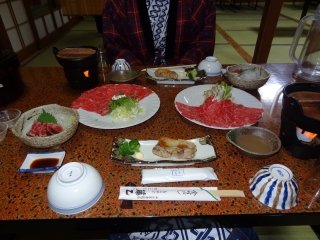
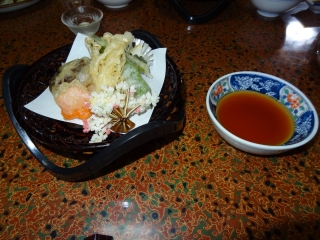
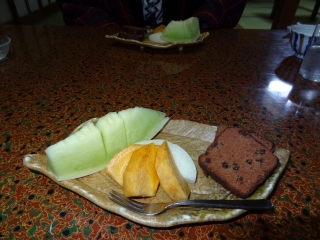
Recent Comments